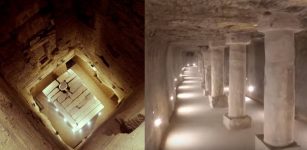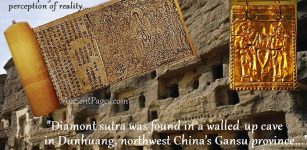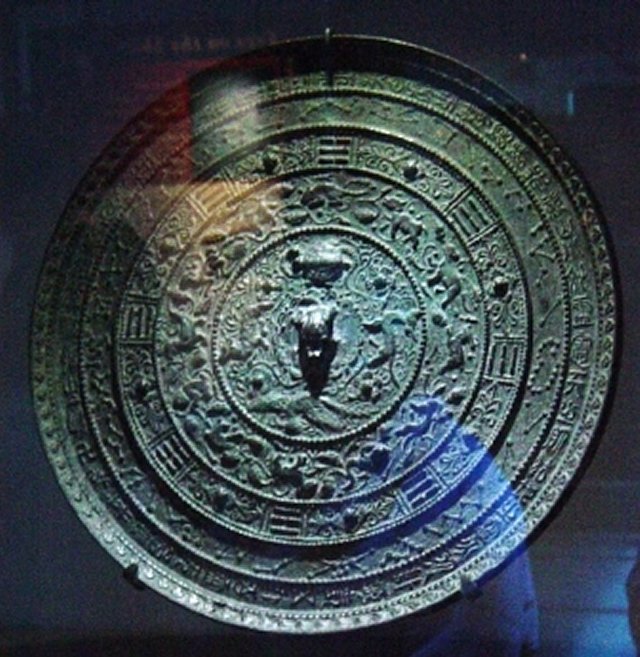Giant Solar Mirrors And Sophisticated Lenses – Advanced Ancient Technology Used By Our Ancestors
Ellen Lloyd - AncientPages.com - Proof of advanced ancient technology can be found in many places. We come across artifacts that re-write history and offer evidence our ancestors were more advanced than we previously thought.
Not all ancient objects can be found, but there are several descriptions of remarkable high-tech devices in myths legends and sacred texts.
Scientific benefits of lenses were known to our ancestors already thousands of years ago. Although the telescope was officially invented in the 16th century, it is possible that ancient Assyrian astronomers used the so-called Nimrud lens that allowed them to watch the skies nearly 3,000 years earlier.
The Minoans were the Bronze Age civilization of Crete that thrived from about 3000 BC to about 1100 BC. These people created tiny, wonderful seals, which were skillfully carved out of soft stones, ivory, or bone. Undoubtedly their creation required extraordinary skills of craftsmen and special tools.
Researchers have long wondered over technologies used by the ancient people. How did the Minoans make tiny, microscopic engravings? To produce such images, they must have used at least one tool to magnify the surface. Did the Minoans learn how to use lenses from the Babylonians perhaps?
Crystal Lenses Used In Ancient Egyptian And Babylonian Temples
The use of crystal lenses was common in ancient Egypt. In our article Mystery Of Ancient Ever-Burning Lamps, we discussed the possibility that our ancestors discovered the secret of eternal light.
Flavia Anderson discussed the subject of advanced light sources in her book “The Ancient Secret: Fire from the Sun”. She suggests that many Grail legends are based on the existence of ancient crystal lenses.
These crystals lenses were precious objects used by priests in ancient Egyptian and Babylonian temples, especially during religious ceremonies.
Anderson also thinks that the legend of the Phoenix Bird, rising from the ashes of the fire that consumes it, maybe based on certain rituals that used a magnifying crystal. The legend of the Phoenix Bird was known to a number of ancient civilizations. Roman, Greek or Egyptian mythologies speak about an amazing mythical firebird, Phoenix, a symbol of Sun, immortality, rebirth, resurrection, and eternal life.
This mythical creature has also its counterpart in China, Japan, and India, and in each of these cultures, many appearances of Phoenix have been created but all of them have similar significance. They are all alike.
Anderson thinks that a special lens was used to focus the sun on some dry straw or other tinder and a trained bird then played in the fire. She demonstrates in her book that a trained bird, a rook, in this case, can play with fire in this manner and not be burnt or harmed in any way.
Perhaps ancient crystal lenses do explain the legend of the Phoenix Bird.
Knowledge of crystal lenses spread from Egypt and near East to South America. “The Spaniards recorded on their arrival in Peru that the heathen priests were accustomed to light their sacred fires from the sun’s rays by means of a concave cup set in a metal bracelet,” Childress writes in his book Technology of the Gods.
Ancient Secrets Of Magical Mirrors
In Ancient China and Japan, people were familiar with so-called magical mirrors. The exact origins of ancient Chinese “magical” mirrors are unknown. About 1,200 years ago, a book entitled 'Record of Ancient Mirrors' still existed and contained the secrets of these enigmatic objects and their constructions. Unfortunately, the book has been lost for over a thousand years.
Today, we wonder what secrets lie behind the thousand-years-old “magical” mirrors that have the creepy ability to project patterns from the back when light is shining on the front?
See also:
Sophisticated Lenses Of Minoans Discovered In The Sacred Idaion Cave
Advanced Ancient Technology – Talos A Greek Robot Created By The God Of The Forge
Mysterious Jade Cong – Perplexing Ancient Chinese Artifact
In ancient China, there is one type of rare mirror called 't’ou kuand ching', which means literally “light-transmitting mirror”. When a strong light strikes the undecorated polished front surface and is reflected onto a wall or screen, the patterns decorating the back of the mirror mysteriously appear in the reflection.
Giant Solar Mirrors Used As Ancient High-Tech Weapons
Ancient Chinese legends describe a Ying-Yang mirror that was carried by warriors to burn the enemy.
Of all giant solar mirrors, the most famous invention was created by the Greek mathematician and scientist Archimedes, born in 287 B.C. Some alternative history researchers call it an “ancient death ray”.
The fearsome solar mirror was used in the Battle of Syracuse in 212-215 BC, to set fire on the invading Roman fleet.
The evidence and knowledge of Archimedes’ work on machines of war comes to us from later historians such as Polybius, Livy, and Plutarch. It means it’s difficult to determine with certainty what really happened. However, from the writing of Zonares and Tzetzes, we learn that a large mirror was used during the Battle of Syracuse.
“When Marcellus [The Roman General] had placed the ships a bow shot off, the old man [Archimedes] constructed a sort of hexagonal mirror. He placed at proper distances from the mirror other smaller mirrors of the same kind, which were moved by means of their hinges and certain plates of metal.
He placed it amid the rays of the sun at noon, both in summer and winter. The rays being reflected by this, a frightful fiery kindling was excited on the ships, and it reduced them to ashes, from the distance of a bow shot. Thus, the old man baffled Marcellus, by means of his inventions.”

Soldiers using multiple flat mirrors could concentrate light on a ship. Image credit & copyright: Lee Krystek, 2011)
Archimedes was able to create this giant mirror and parabolic disc and focus the Sun’s rays on a fleet and set the ships on fire.
Using a magnifying glass to concentrate the sun's rays onto a small piece of wood, setting it on fire can be done easily. However, those who questioned the Archimedes’ method wondered if he could have built a mechanism with the tools he had available at the time to concentrate enough sunlight to set the deck of a wooden ship on fire.
Some years ago, the Mythbusters television crew attempted to reconstruct the ancient battle, using 500 flat mirrors controlled by 500 volunteers. They tried for one hour to focus the Sun on a sail (which should have had an ignition point of only about 500 degrees Fahrenheit) they could only get the temperature up to about 230 degrees.
The television crew concluded that it was theoretically possible to set a ship on fire with mirrors, but it was unlikely Archimedes used this method in battle.
Those who disagree with this conclusion suggest that mirrors could have been used on the crew and not the ship. A light beam focused on you could raise your skin temperature to over 200 degrees and it would be extremely unpleasant. It would also force the crew of the attacked ship to jump into the water.
We may never know how Archimedes’ giant solar mirror was used in battle, but we do know that our ancestors possessed advanced knowledge that covered lenses, different forms of light sources, and weapons we today are not yet fully familiar with. Though we cannot answer all questions, awareness of the past gives us the resources necessary to make comparisons between our contemporary world and past times. This knowledge shapes our future.
Written by Ellen Lloyd – AncientPages.com
Copyright © AncientPages.com & Ellen Lloyd All rights reserved. This material may not be published, broadcast, rewritten or redistributed in whole or part without the express written permission of AncientPages.com and Ellen Lloyd
Expand for referencesMore From Ancient Pages
-
 Early Humans In Europe Were Making Fires At Least 250,000 Years Ago – New Study
Archaeology | May 18, 2023
Early Humans In Europe Were Making Fires At Least 250,000 Years Ago – New Study
Archaeology | May 18, 2023 -
 Inanna – Prominent And Highly Honored Mesopotamian Goddess
Featured Stories | May 31, 2021
Inanna – Prominent And Highly Honored Mesopotamian Goddess
Featured Stories | May 31, 2021 -
 On This Day In History: The ‘Canterbury Tales’ Read For The First Time At Richard II’s Court – On Apr 17, 1397
News | Apr 17, 2017
On This Day In History: The ‘Canterbury Tales’ Read For The First Time At Richard II’s Court – On Apr 17, 1397
News | Apr 17, 2017 -
 Mythical Shield-Maidens Did Exist – Evidence Of Female Viking Warriors Discovered
Archaeology | Sep 9, 2017
Mythical Shield-Maidens Did Exist – Evidence Of Female Viking Warriors Discovered
Archaeology | Sep 9, 2017 -
 Cuauhtémoc: Brave And Determined Ruler Of Tenochtitlan And The Last Aztec Emperor
Featured Stories | Feb 28, 2018
Cuauhtémoc: Brave And Determined Ruler Of Tenochtitlan And The Last Aztec Emperor
Featured Stories | Feb 28, 2018 -
 The Aztec Sun Stone And Medusa Reveal An Intriguing Connection – A Different Gorgon And Strange Location – Part 2
Ancient Mysteries | Aug 1, 2018
The Aztec Sun Stone And Medusa Reveal An Intriguing Connection – A Different Gorgon And Strange Location – Part 2
Ancient Mysteries | Aug 1, 2018 -
 On This Day In History: Knights Templars’ Jacques de Molay Burned At The Stake – On Mar 18, 1314
News | Mar 18, 2017
On This Day In History: Knights Templars’ Jacques de Molay Burned At The Stake – On Mar 18, 1314
News | Mar 18, 2017 -
 Ancient City Of Metsamor – Captured And Destroyed By Argishti I, The Ruler Of Urartu
Civilizations | Sep 11, 2015
Ancient City Of Metsamor – Captured And Destroyed By Argishti I, The Ruler Of Urartu
Civilizations | Sep 11, 2015 -
 Archaic Marble Lions On The Sacred Island Of Delos
Artifacts | Feb 27, 2021
Archaic Marble Lions On The Sacred Island Of Delos
Artifacts | Feb 27, 2021 -
 Binary Code Was Used In Ancient India And Polynesia Long Before Leibnitz Invented It
Ancient Technology | Sep 28, 2017
Binary Code Was Used In Ancient India And Polynesia Long Before Leibnitz Invented It
Ancient Technology | Sep 28, 2017 -
 Magnificent Interior Of The Djoser Pyramid Revealed In Stunning Images And Video
News | Mar 14, 2020
Magnificent Interior Of The Djoser Pyramid Revealed In Stunning Images And Video
News | Mar 14, 2020 -
 On This Day In History: Vespasian Was Elected The Roman Emperor – On July 1, 69 A.D.
News | Jul 1, 2016
On This Day In History: Vespasian Was Elected The Roman Emperor – On July 1, 69 A.D.
News | Jul 1, 2016 -
 Ancient Entrance Gate Found In Biblical City Of Bethsaida (Zer) Where Jesus Performed His Deeds Of Power
Archaeology | Jul 11, 2018
Ancient Entrance Gate Found In Biblical City Of Bethsaida (Zer) Where Jesus Performed His Deeds Of Power
Archaeology | Jul 11, 2018 -
 Stikini ‘Man-Owl’ – Sinister Vampiric Monster That Works In Disguise
Featured Stories | Jan 29, 2019
Stikini ‘Man-Owl’ – Sinister Vampiric Monster That Works In Disguise
Featured Stories | Jan 29, 2019 -
 Remarkable Kailashanatha Temple And Unique Passage Of Life Cycle Including Aging, Death And Rebirth
Civilizations | Mar 26, 2017
Remarkable Kailashanatha Temple And Unique Passage Of Life Cycle Including Aging, Death And Rebirth
Civilizations | Mar 26, 2017 -
 1,800-Year-Old Richly Painted Tomb Unearthed In Northern Jordan
Archaeology | Oct 1, 2018
1,800-Year-Old Richly Painted Tomb Unearthed In Northern Jordan
Archaeology | Oct 1, 2018 -
 Golden ‘Etruscan’ Orphic Book – Six Golden Pages Of The Oldest Book In History Of Mankind
Artifacts | Mar 27, 2020
Golden ‘Etruscan’ Orphic Book – Six Golden Pages Of The Oldest Book In History Of Mankind
Artifacts | Mar 27, 2020 -
 The Wild Hunt And The Danger Of Seeing The Phantom Army Of Odin
Featured Stories | Dec 8, 2024
The Wild Hunt And The Danger Of Seeing The Phantom Army Of Odin
Featured Stories | Dec 8, 2024 -
 Large Previously Unknown Roman City Discovered At The Foot Of The Pyrenees
Archaeology | Jul 16, 2022
Large Previously Unknown Roman City Discovered At The Foot Of The Pyrenees
Archaeology | Jul 16, 2022 -
 Struggle To Get Mail On Time Has Lasted More Than 5,000 Years – Part 3
Featured Stories | Aug 1, 2017
Struggle To Get Mail On Time Has Lasted More Than 5,000 Years – Part 3
Featured Stories | Aug 1, 2017




